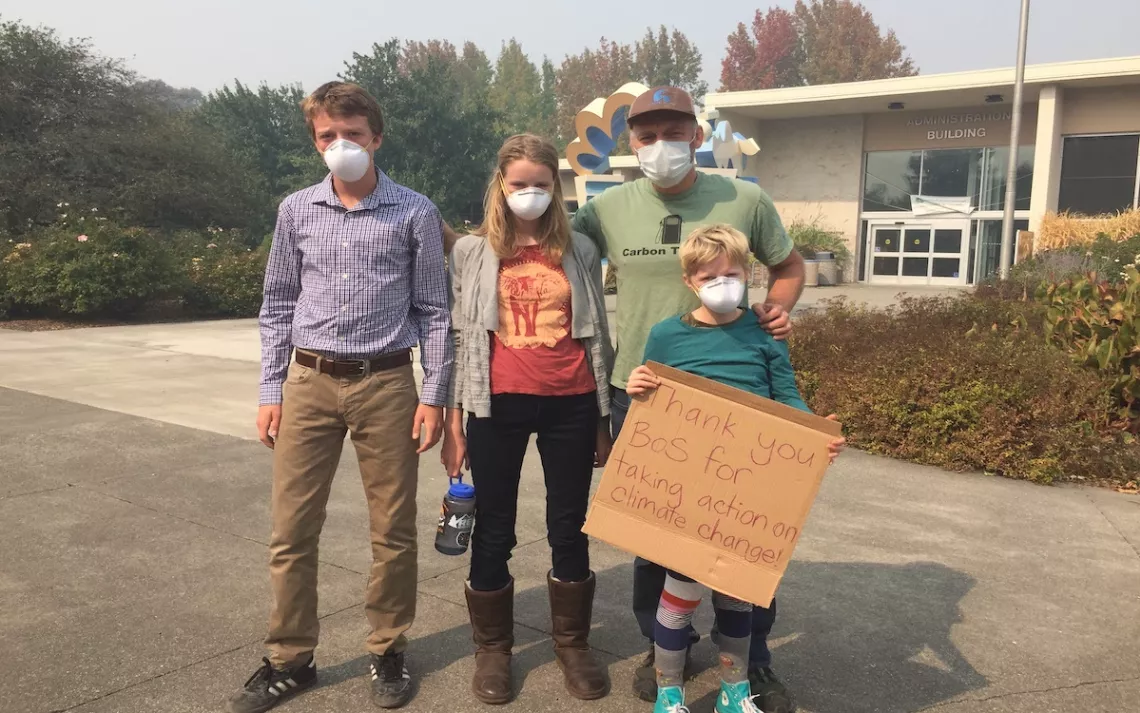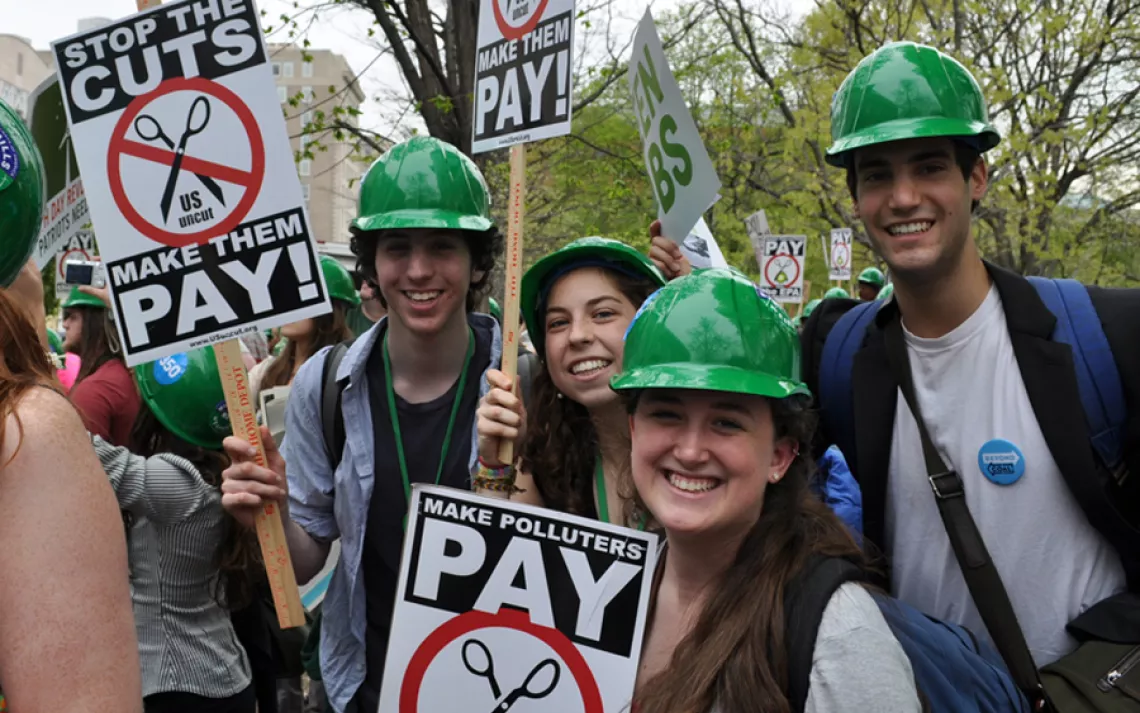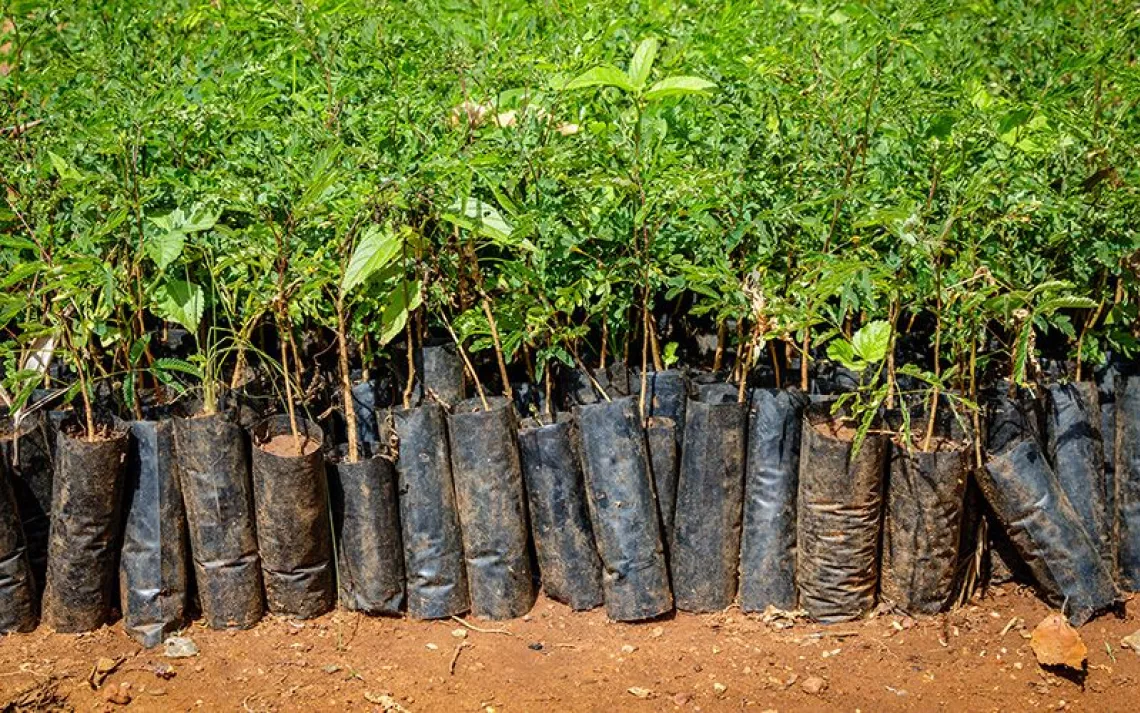Schools for Climate Action Takes on Climate Denial in Schools
A California educator pushes institutions to take action on climate change

Park Guthrie and his children during the 2017 Tubbs Fire. | Photo courtesy of Park Guthrie and Schools for Climate Action
Park Guthrie sits at a picnic table in an idyllic stand of redwoods in Occidental, California, an hour north of San Francisco. The woods mark the perimeter of Salmon Creek Middle School, where Guthrie, 50, has been teaching sixth grade for the past six years. Salmon Creek’s educational mission, Guthrie explains, is “place-based,” meaning that subjects are taught with an emphasis on the local environment—and lately the environment has been telling a powerful and unequivocal story about the state of the planet, he says.
The 2017 fires in Sonoma County burned entire neighborhoods and blanketed the region in choking smoke. “Huge parts of Santa Rosa, which is just a few miles up the road, were destroyed,” he told Sierra. “Our kids were out of school for weeks. The whole thing was unprecedented.” Then came last winter’s flooding of the Russian River, which inundated the town of Sebastopol and the homes of many of his students. In light of these mounting signals of California’s rapidly changing climate, Guthrie knew he had to do something. “As educators we are trained to look for signs of neglect in our students,” he said. “And when we see it, we are required by law to take action. Our inaction on climate change is generational neglect.”
In 2017, Guthrie and a fellow teacher founded Schools for Climate Action, a nonprofit that helps school boards, teacher unions, student councils, and other educational organizations draft and adopt climate action resolutions. These ambitious statements acknowledge the threat of climate change and, in many cases, present plans to reduce the impacts from carbon emissions. Since the group was founded, more than 600 people have participated in events and campaigns, including summits in Sonoma County and DC. And by Guthrie’s latest count, 100 organizations in 13 states have ratified climate action plans. One of the most far-reaching was passed in 2018 by the Albany Unified School District in the San Francisco Bay Area, which “call[s] on Congress . . . to protect current and future students, fully funding climate change research, coordinating federal climate change actions with those of California, and holding the Environmental Protection Agency accountable for protecting public health and welfare.”
For years before starting Schools for Climate Action, Guthrie worked as a volunteer for Citizens’ Climate Lobby, a grassroots advocacy group that promotes bipartisan efforts to address climate change. His experience there helped him conceive of the organization’s focus. He realized that schools are not only institutions entrusted with the well-being of children; they are also places of scientific learning. This combination of missions, Guthrie says, gives schools and teachers a special kind of authority and responsibility to speak out on climate science.
That authority is being challenged as never before. The country’s classrooms have become a target of climate change denialism as influential conservative leaders and organizations have waged a campaign to distort, dispute, or eliminate altogether climate change from science curriculum. In 2017, Secretary of Education Betsy DeVos’s family-run foundation gave millions to educational groups advocating positions that run counter to the scientific consensus on climate change. That same year, the Heartland Institute, a conservative think tank with close ties to the fossil fuel industry, sent teaching materials to science teachers across the country asserting that climate change is triggered by natural rather than human causes. Last year, Idaho legislators scrubbed all mentions of human-induced climate change from state science guidelines.
Guthrie recounts a meeting in 2017 with California Republican congressman Tom McClintock as an example of the virulent propaganda, underwritten by fossil fuel dollars, that has railroaded the conversation. “He and his staffers spouted pseudo-scientific theories,” he said. “If I tried to teach that stuff in my class, I’d be fired.” In this politically charged, anti-science environment, it’s not enough for teachers to merely teach, says Guthrie. “We have to address the power structures that are preventing action,” he said. “If we don’t, if we remain silent, then we aren’t really doing our job.”
In addition to lobbying school administrators to speak with a collective voice on climate, Guthrie is also helping his students speak on their own behalf. “Climate change will affect the lives of all young people,” said seventh grader Simi Lander. Earlier this year, she and a group of Salmon Creek students successfully lobbied the California Association of School Psychologists to pass a climate resolution. “We convinced them that climate change is the most important issue impacting the health of children,” she said. “They are the first organization representing school psychologists in the country, maybe the world, to pass this kind of resolution.” In March, Guthrie took a group of several local students, including two of his children—Kai, 16, and Lola, 15—to Washington, DC, to meet with congressional representatives about the need for aggressive action to stem global warming. This term, he is teaching a new class on climate advocacy, which, he hopes, will give students the tools necessary to carry the fight for climate justice into the years ahead.
This tide of misinformation and partisan politics around climate flowing out of Washington, DC, has seeped into the administration of the nation’s schools, Guthrie says. “There are roughly 90,000 elected school board members in the country,” Guthrie said. “And yet, by and large, they are completely silent on the matter. They fear sharing their opinion and ‘getting out of their lane.’” That assumption is based on his own experiences at Salmon Creek. Improbable as it seems, Guthrie has even encountered resistance from administrators in his own school district. “The school sits in this magnificent forest,” he said. “Our curriculum is focused on place-based learning and sustainability. We have solar panels and a garden program. The building even has a green roof. And yet, the former superindentent was someone who denied climate change. It was as if this person was asking the entire staff and student body to deny reality, to ignore what was happening in front of their eyes.”
Fighting such entrenched anti-scientific thinking is a daunting task—particularly in the “alternative facts” era of Donald Trump—but Guthrie’s advocacy work has also led him to believe that a solid majority of teachers and administrators understand climate science and accept its dire warnings. And things can change fast, he believes. “One hundred climate action resolutions is small when you consider that there are thousands of educational organizations out there,” he said. “But at the beginning of the year, we only had 29.”
Like the proverbial snowball rolling down the mountain, says Guthrie, the climate action movement will continue to gather momentum. There will come a moment of reckoning, he believes, a tipping point in which direct, mass-scale action becomes unavoidable. “There are a lot more of us then there are of them,” he says. “It’s way too early to believe that the lobbyists have us beat.”
 The Magazine of The Sierra Club
The Magazine of The Sierra Club



